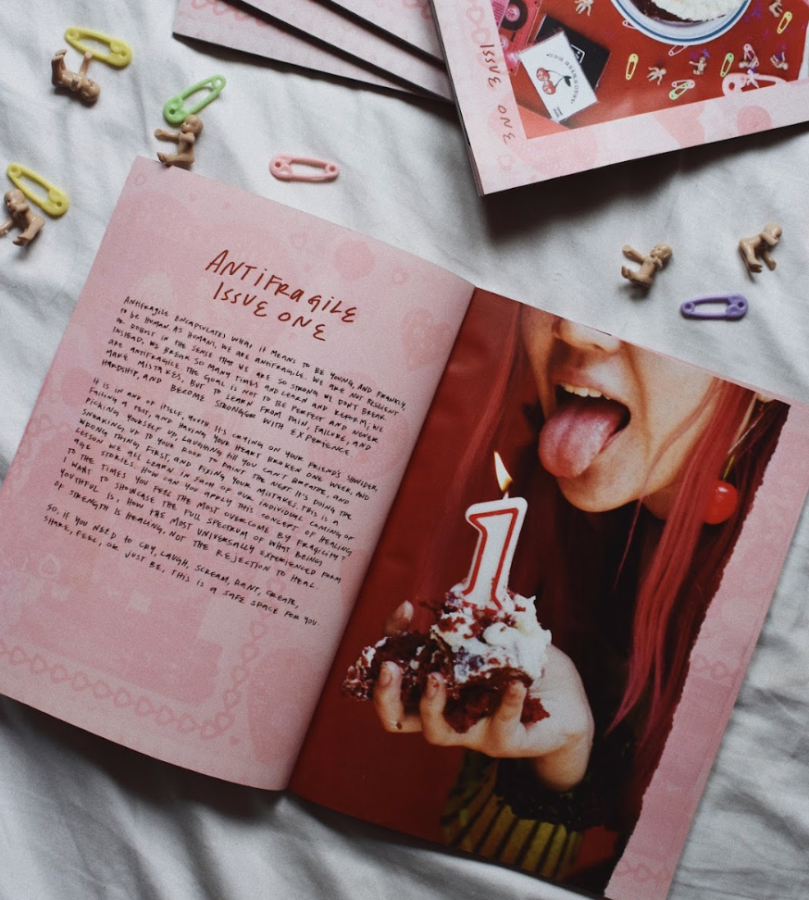Since the start, the Antifragile Zine, a youth artist collective, has worked to share underappreciated stories and build community through media, writing, and art.
During the summer of 2020 – in the midst of the COVID-19 pandemic – Sixth College junior Macey Keung was bored. Mindlessly scrolling through Instagram, she noticed that one of her mutuals, Miumi Shipon, had posted about wanting to start some kind of artist collective.
Keung, a media major and visual arts minor, reached out to Shipon. The two realized that they shared a very similar vision for a new kind of space, somewhere to share stories and uplift new voices through art and media — a zine, perhaps. A few months later, the Antifragile Zine was born.
For those unfamiliar with the concept, a “zine” is a type of magazine, generally self-published and home to a scrapbook-like collection of visual and written work. Zines have historically been places for people to express and share their creative niches. Keung and Shipon envisioned creating their own niche, a zine made by and for marginalized youth. Antifragile highlights women and nonbinary people of color through art, essays, and anything else contributors want to share.
Within a month of launching their Instagram account, they had built a platform of over 1,000 followers and received 200 submissions from all around the world for their first to-be-published issue of the zine. Keung and Shipon amassed a staff of over a dozen and began to conduct outreach through social media. In the beginning, Keung explained, they would reach out to hundreds of artists and creators on Instagram, telling them about the zine and requesting that they submit submissions.
Keung attributes some of their early success to her peers’ need for connection.
“I think it was the nature of quarantine and everybody really wanting to feel connected to other artists and be a part of something larger. Especially not having an outlet that we really felt seen and heard by, and [Antifragile] was an embodiment of that safe space,” Keung told The UCSD Guardian.
So Keung and Shipon turned their vision into a reality. On Sept. 1, 2020, the first issue of the Antifragile zine was published with a focus on combating romanticized ideas of youth.
During quarantine, both Keung and Shipon had been feeling mutual frustration about the lack of accurate representations of the youth experience in the media. Keung described the picturesque, redundant, and “overly-romanticized coming-of-age aesthetic” that plagued the media. This image was not reflective of their own experiences of youth, nor that of their peers. This frustration gave way to the concept for their first issue, a more raw and real reflection of youth.
Antifragile’s name came to fruition when Keung remembered a conversation she had with a friend a few years back.
“It’s this idea of humans being antifragile… we’re not resilient or robust or so strong in the sense that we don’t break; instead, we break over and over and reform and grow from our mistakes,” Keung said. “The goal is not to be perfect, but to learn from our mistakes and hardships.”
Keung felt it was a perfect embodiment of what she was going for: the raw, natural youth state.
Antifragile’s platform now operates on three levels: print, in-person, and online. Besides the print issues of the zine that are periodically carefully curated by Keung’s staff, Antifragile hosts events, shares stories and art online, and uses social media to support causes that matter to them. Though the in-person aspect of Antifragile operates on a local level, its audience is worldwide.
They’ve received submissions from Hong Kong, Taiwan, Mexico, Canada, the UK, and all over Europe.
Keung described hosting Antifragile’s first in-person event in December of 2021. Antifragile organized an event where female punk bands performed at the Loft in Price Center on campus. Keung was worried at first because she wasn’t sure if it would gain traction or popularity among students. But when the time came, the event was a success.
“We probably had 250 people attend the event in total,” Keung said. “That is when I realized that this creative community does exist at UC San Diego, and there just [haven’t] been that many places for it.”
Sophomore Avni Sardana joined Antifragile in October 2021 just a few months after arriving at UCSD. Sardana is a speculative design major in Eleanor Roosevelt College and was ecstatic to find the arts community she felt had been missing from her college experience thus far. In fact, Antifragile’s staff is made up of over a dozen UCSD students committed to sharing stories through the zine.
“I love being able to contribute and have that sort of platform to make people feel like they genuinely have a voice. It gives me a voice too,” Sardana said about her involvement with Antifragile.
Sardana had been interested in zine culture in high school, and was excited to find an opportunity to get involved with one at UCSD.
After being a photographer for the magazine, Sardana took on a bigger role in the organization as Keung’s “right-hand man,” in her words. She works with Keung and other staff to go through submissions and organize spreads, alongside more managerial work like delegating tasks, keeping track of deadlines, and organizing and tabling events. Sardana found a community through Antifragile, one that she felt she really needed.
In the production of each issue, Keung and her team come together to go through submissions, which range from late-night confessions to personal art and photography. Each zine has 40-70 collaborators and is packed to the brim with carefully curated spreads of submissions.
Submissions can include poetry, photography, doodles, screenshots, handwritten notes or sketches, diary entries, and more. With the submissions of their choice, Antifragile designs, prints, and distributes its zine to the community. Keung estimates that she spends at least 200 hours working on each zine, cutting, pasting, and organizing pages for hours on end.
Sardana also devotes her life to the zine.
“It’s intentional that it’s this time-consuming for me. I love it,” Sardana said. Carrying the weight of an organization like Antifragile isn’t an easy task, but for both Keung and Sardana, it’s worth every minute.
“Running Antifragile full-time and being a college student full-time is definitely not easy, but this is the single thing that has brought me the most meaning in life and in what I do,” Keung said. “It’s my biggest passion, and I carry it with me in everything that I do and everything that I’m learning.”
Keung and Sardana value every submission they receive, from research-based essays to heartfelt confessions.
“We definitely prize personal essays [and] more personal experiences on identity,” said Keung. “To be on the receiving end, that’s so meaningful and heartwarming. It’s really cool that people trust us with their work that can be so personal to one artist or individual.”
The physical aspect of the zine has become symbolic for its team and is part of what inspired the concept for their fourth and most recent issue, which is currently in the works.
“I think, in a time where so much of our content exists online, it’s really special to have something physical,” said Keung. Not only does the physical zine differentiate itself from online forms of art and content, Sardana, too, but also finds value in the simple act of having a book in her hands.
“I think for me that tactility really just provides a stronger connection to what you’re reading,” Sardana said. “It’s kind of like being in a museum and being able to see the art in person is so different than when you see it online. You can really take it in, and then you can go back to it whenever you want, display it, and have it in any way you like.”
Every issue of Antifragile has been a projection of a particular idea that stands out to its staff — a concept that they feel is important to share. With each issue, Antifragile produces an embodiment of their goals and values, sharing stories that have often been left untold. Their second issue honed in on the idea of taste and how “good taste” has been defined primarily by white men. They aimed to expand this idea and explore new interpretations and definitions of taste. Their third issue expanded on that idea, exploring “the cycle of shame and internalization felt by BIPOC in the context of cleanliness and dirtiness.”
For their fourth issue, Keung wanted to think back to why she started the zine in the first place. She looked to our generation’s obsession with thrifting, vintage, analog, retro aesthetics, and general nostalgia. She sees this obsession almost as a manifestation of the current age of media and of young people’s fears relating to connection and reality.
“Especially when we quarantined and everything was online, and we had this fear of not being real, I think that’s a very universal experience for our generation right now,” Keung said. “I want to talk about that, talk about these issues in a product that will be real.”
A theme was born: anachronism.
The issue will feature 14 writers writing specifically for the theme, alongside its usual incorporation of art, photography, and more. These more article-based writing submissions will feature analyses of Gen Z, covering topics like the pressure to perform, hustle culture, and feminine paranoia. Keung is excited to build on some of the original ideas that inspired the zine in a more curated and cohesive format.
The idea of Antifragile as an artist collective has remained important to Keung since the beginning. Keung’s own perspective as an artist had important implications for what the Antifragile community would look like.
“For me, my process as an artist, I feel like I’m very community-oriented and mission-driven, and to be able to work on something larger with other artists for a bigger purpose is something that’s really meaningful to me,” she explained.
It was important to Keung that Antifragile facilitates genuine connections between artists, their audiences, and communities. Antifragile has a space where BIPOC can create and connect in ways they had never had the chance to before.
“Connection is the best way to create art,” Sardana said. “I think, in my mind, our real values are just providing that space, uplifting marginalized voices, having youth be able to connect and share art together, make people feel heard, and make artists feel seen.”
Keung also wants her audience to know how much work, heart, and soul goes into every page.
“I made sure that we absolutely loved every page [and] that it had meaning,” she said. “Not only is [Antifragile] a zine, it’s a place, a safe space, and a community for those who have felt unseen by mainstream media.”
Sardana has found a community and a purpose through Antifragile.
“I would say probably the best part of the process is just seeing everything come together,” she said. “These are 2 a.m. bedroom ideas [that] literally started from something so small and spiraled into this big thing where we have 200 submissions from all over the world.”
As long as there’s a need to create and speak out, Antifragile will exist.
“[Antifragile] will stay alive because of that fundamental need as an artist to create something and to connect with others,” Keung said.
She dreams of an even bigger future for Antifragile, perhaps a physical manifestation of this need for community, in the form of an event venue or studio space. Much like the title itself, both Antifragile’s past and future represent persistence and possibility.
Photo courtesy of Macey Keung















